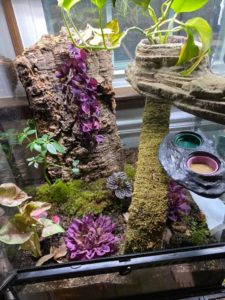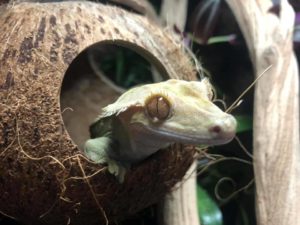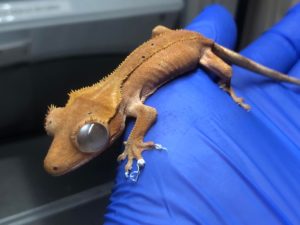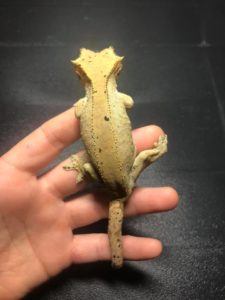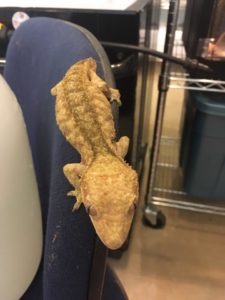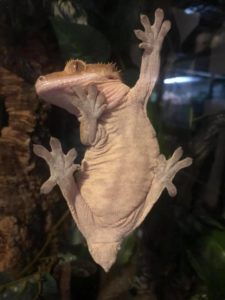CRESTED GECKO
Species name: Correlophus ciliatus
Lifespan: 15-20 years
Origin: New Caledonia
Adult size: 5-8 inches
Caging
We recommend at least a 20 gallon arboreal enclosure for a crested gecko. If you’re using an Exo Terra, the recommended size is 18” x 18” x 24”. A plastic bin enclosure or PVC enclosure is also acceptable as long as ventilation is available and the size is correct. For baby crested geckos, we recommend keeping them in small plastic bins. They are very fragile as babies and need higher humidity. A 16 quart Sterilite bin can be used for a baby crested gecko, and juveniles can be moved up to 10 gallon enclosures or 12” x 12” x 18” Exo Terras.
Decor
Crested geckos should have lots of foliage and branches. They are arboreal, so they love to climb and will spend most of their time off the ground. We really like corkbark, as it provides them with good climbing space and is resistant to mold in high-humidity setups. You can also use other wood branches, fake vines such as Fluker’s Bend-A-Branch, and fake or real plants.
Humidity
Crested geckos do require a high humidity, between 60-70%. Spikes of up to 80-90% are acceptable, but the cage should have a daily “dry out” period and not be constantly wet. We maintain this higher humidity by misting the enclosure once daily for about 10-15 seconds. Having a bioactive enclosure is also helpful, as the substrate can be kept slightly moist and the live plants will help to keep the humidity high.
Substrate
Paper towels can be used but they must be cleaned frequently. A basic particulate substrate such as Eco Earth and sphagnum moss is also an option, but be sure to mist it to keep it damp as it can become dusty if dry. Personally, we love keeping crested geckos in bioactive enclosures. They’re probably the easiest species to keep this way, as the high humidity in their enclosure makes it easy for the plants and microfauna to stay alive! If you choose to go bioactive, do a lot of research on how to create a functioning bioactive environment. You’ll need a drainage layer, substrate barrier, good substrate (soil or ABG mixes), leaf litter, and added microfauna to clean up organic material. Microfauna, or “clean up crew,” includes springtails and isopods, and can be purchased online to add to your enclosure. For isopods, we do not recommend scaber species (Porcellio scaber) as they are protein-driven and may nibble on soft-bodied reptiles such as geckos. Dwarf white isopods are our personal favorite for crested gecko setups. Live plants also do well in a bioactive enclosure, and we’ve had success with pothos, dracaenas, syngoniums, Schefflera, and begonias. Check out the website Josh’s Frogs for more information on setting up a proper bioactive enclosure.
Heating
External heat is not necessary for crested geckos, as they do best at slightly cooler temperatures around 70-75°F. If your house is very cold, you can use a low-wattage ceramic heat emitter or deep heat projector on a thermostat. If you do, make sure to closely monitor the humidity, as this can dry out the enclosure and cause additional issues. We do not recommend using a heat pad, as it just isn’t very effective in a tall enclosure. Regular reptile heat lamps should be avoided as they are too hot and will quickly dry out the enclosure.
Lighting
Lights are optional for crested geckos. They do not need a UVB light, as they convert all their vitamin D3 dietarily. We have not seen any direct evidence that UVB light is necessary for crested gecko metabolism, but it certainly can be used. If you want to provide a UVB light, use a lower percentage such as a 2.5-5% or an Arcadia Shade Dweller. Do not use a strong basking bulb as this will dry out the humidity levels. LED lights or incandescent lights can be used for viewing. If you have live plants, they require specialized plant lights to thrive.
Diet
Crested geckos have one of the easiest diets for captive reptiles! In the wild, these geckos eat fruit and insects. In captivity, they should be fed specially formulated crested gecko diets. Our personal favorite is a brand called Pangea, but Repashy is also popular. These diets are nutritionally complete and include insects, fruit, and all of the necessary vitamins and minerals. The diets are sold in powder form and mixed with water to form a “smoothie”. We feed Pangea every other day, and you can make these diets to stay in the fridge for up to a week. Live insects are not necessary, but younger cresteds especially do enjoy them. Any live insects fed, such as crickets or dubia roaches, should be gut-loaded with a nutritious diet and dusted with calcium. An insect-only diet is not sufficient for this species.
Supplementation
Crested geckos do not require additional supplementation as long as they’re eating a good commercial diet such as Pangea or Repashy.
Water
A small bowl of clean water should always be available.

Things You Should NOT Do
Use arid substrates: Do not use arid substrates such as sand or wood shavings. You will quickly dry out your gecko and it can lead to issues shedding and dehydration.
Use a red heat lamp: Reptiles CAN see red light and this will disturb their sleeping cycles. If you need additional heat at night, use a ceramic heat emitter.
Use a high wattage basking lamp: Crested geckos thrive in cooler temperatures. If you use a basking lamp made for iguanas or bearded dragons, your gecko will likely suffer burns, shedding issues, or dehydration.
Use a heat rock: While many pet stores will try to sell you a heat rock, they are extremely dangerous. Do not use them for any animal. Heat rocks are not well regulated and can reach temperatures high enough to severely burn your animal.
Cohabitate: Crested geckos should always be housed singly. They can, and often will, show aggression towards each other, including nipping toes and tails. This can lead to severe injuries and infections.
Common Health Issues
Burns: Do not use basking lights with crested geckos. If using a ceramic heat emitter or deep heat projector, use a thermostat to keep the temperature around 75-80°F maximum. If your gecko does suffer a burn, seek veterinary attention immediately to assess the severity of the burn and treat it properly.
Dysecdysis/Retained Shed: This is very common with crested geckos, as they are often kept in low humidity enclosures. Stuck shed can accumulate around the toes and tail, and cause them to become necrotic and fall off. It can also cause secondary bacterial infections, so stuck shed can quickly become serious if not removed and treated.
Eye Infections: This is not common in crested geckos but can occur when the gecko is kept in dirty or overly wet environments. It can also occur as a secondary infection if there is stuck shed that collects in or around the eye. Make sure to maintain a clean environment and see a veterinarian if your gecko’s eyes are red, swollen, or cloudy.
Tail Loss/Autotomy: Crested geckos have the ability to drop their tail if they feel threatened. Unlike other geckos, their tail will not grow back. This is quite common in crested geckos and many are tailless. This doesn’t seem to affect them very much in captivity and they can still live active, full lives!
Kyphosis/Spinal Kink: This is possible in crested geckos and we have seen several cases of it. Usually it is due to genetic issues or temperature spikes in the egg. Most crested geckos with spinal kinks aren’t affected very much and can live full, active lives. They might need additional help shedding depending on the severity of the deformity.
Metabolic Bone Disease: MBD, also known as nutritional secondary hyperparathyroidism, is rare in crested geckos as Pangea/Repashy diets have all the necessary vitamins and minerals. If your gecko is not eating an appropriate diet, MBD is possible. Signs of MBD include curved limbs, kinks in the spine or tail, lethargy, or paralysis in the hind limbs. If your lizard is showing signs of MBD, see a veterinarian to assess the severity and start treatment. This may include oral liquid calcium and dietary correction. MBD can be fatal if untreated.
Mouth Rot: Mouth rot, or ulcerative stomatitis, is a condition where the mouth develops a bacterial infection. This can be due to a dirty water source or dirty enclosure, a wound in the mouth or nose rub that becomes infected, or stuck shed around the face. Mouth rot can quickly become serious, as it is painful and will cause the dragon to not want to eat. You should see a veterinarian, who will clean out the mouth with dilute chlorhexidine or betadine and start an antibiotic regimen if needed.
Scale Rot/Dermatitis: Geckos housed in enclosures that are too wet or not cleaned properly can get infections called scale rot or dermatitis. Your substrate should never be dripping wet or grow mold. Additionally, always make sure your gecko has plenty of branches and foliage to rest on above the substrate. Remove feces immediately and completely change substrate every 2-3 months, unless it is a fully functioning bioactive. Signs of scale rot include blisters, ulcers, or scabs on the ventral area. Mild cases can usually be treated by placing the lizard in a sterile paper towel setup, soaking in dilute chlorhexidine or betadine, and applying topical SSD cream or triple antibiotic ointment. However, we always recommend seeing a veterinarian to assess severity, as more severe cases may require wound debridement or systemic antibiotics.
Obesity: Obesity is possible in crested geckos, especially older females that are free-fed. If your gecko is overweight, feed a smaller amount of crested gecko diet or dilute the powder with more water. Consider increasing the enclosure size to encourage exercise.
Parasites: Parasites are uncommon in crested geckos, as these geckos are almost completely captive bred and feed on powder diets. However, parasites are still possible if you feed live insects or if your gecko was housed near other reptiles. Reptiles can carry many different types of parasites, including pinworms, coccidia, spirochetes, and protozoans. When a reptile is sick or stressed, the parasites can take over and cause diarrhea, weight loss, regurgitation, and anorexia. This can become serious, so bring a fecal to your veterinarian if your gecko is exhibiting the above signs.
Prolapse: Cloacal prolapses can happen in both male and female geckos, but male geckos can also have hemipenal prolapses. A prolapse is an emergency that should see a veterinarian immediately. If it is recent, sometimes the vet can push the prolapsed tissue back in and place a temporary suture, but advanced prolapses can become infected and necrotic. Some will require amputation. Prolapses can be caused by dehydration, fecal impaction, extreme parasite infestations, or can be from no noticeable cause.
Respiratory Infection: Lizards can develop respiratory infections due to incorrect temperatures, humidity, or unclean conditions; however, this is extremely rare in crested geckos. Signs include open mouth breathing, wheezing, sneezing, and discharge from the mouth or nostrils. Respiratory infections may be caused by bacteria, fungi, or viruses, but the most common are likely bacterial and these are usually treatable. Make sure to identify and rectify the husbandry conditions that may have contributed to the infection, and go to the veterinarian for treatment. In our experience, most cases will respond to a course of ceftazidime or a similar antibiotic, but some are caused by more resistant bacteria that can be identified and treated with a tracheal wash, culture, and sensitivity. Fungal and viral infections are typically more rare and do not have as effective treatments.


